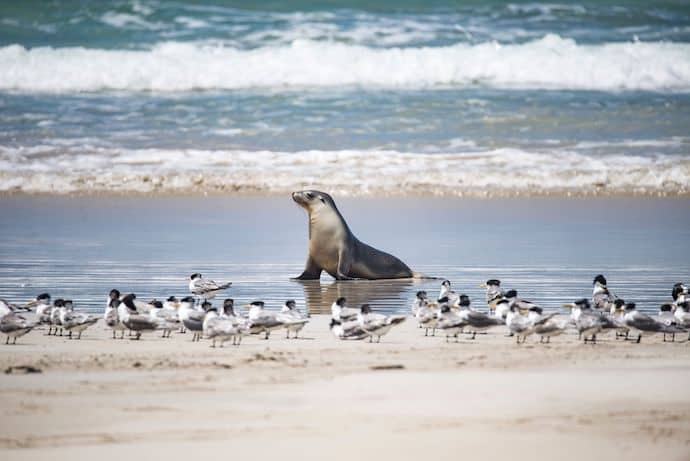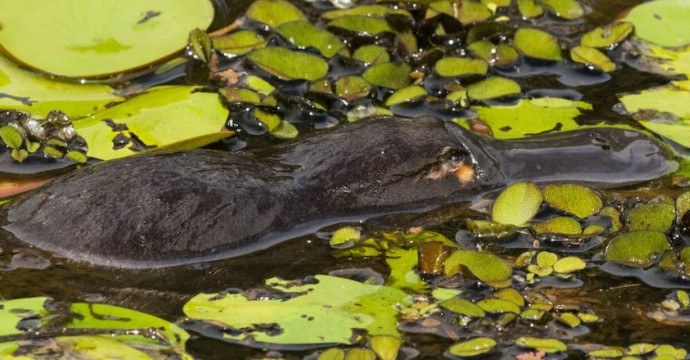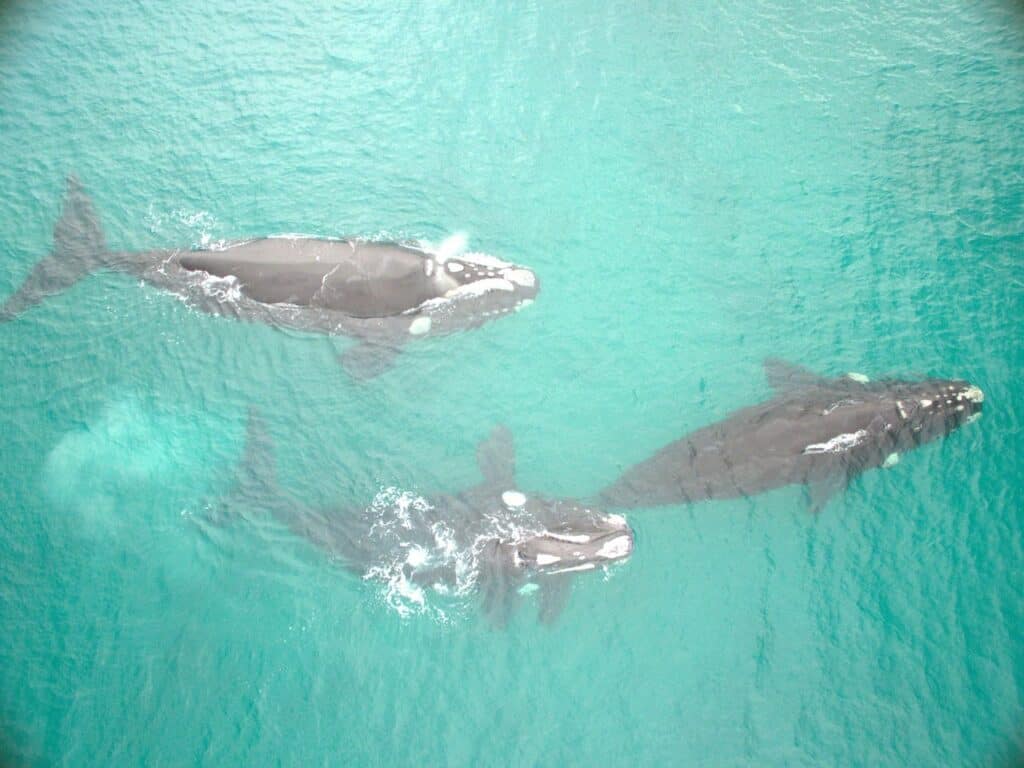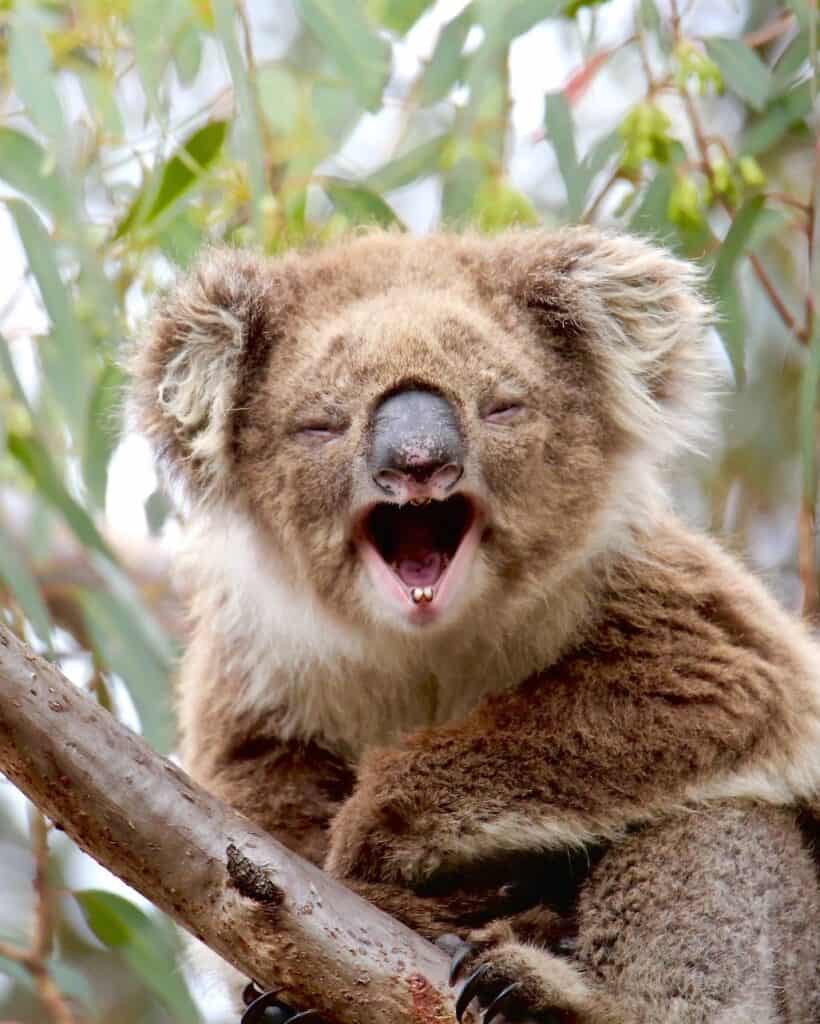Original content owned & copyrighted by Green Global Travel.
This post is brought to you in partnership with Australian Wildlife Journeys. But our opinions remain our own, and we will never compromise the integrity of our responsible travel mission.
For most of us, a dream vacation to Australia conjures up images of one-of-a-kind wildlife that is endemic to the continent, as well as the array of ocean animals that swim offshore.
A trip Down Under simply wouldn’t be complete without some sort of sensational animal spotting.
Australian vacations can be an equally amazing opportunity to spot these amazing animals while also helping the wildlife conservationists working to preserve them for future generations to enjoy.
When you pursue Australian wildlife encounters with conservationists as your guides, the experience automatically comes with a wealth of interesting knowledge and know-how.
After all, these passionate folks spend their professional lives studying and protecting the animals they love!
In short, meeting up with wildlife conservationists adds an unforgettable element to any vacation to Australia. Their professional guidance adds so much more appreciation for the animals and color to the experience.
Fortunately, it’s an easy thing to do. Lots of environmental organizations offer awesome options for traveling Australia while also putting money towards the conservation of Australian animals.
Australian Wildlife Journeys is a fantastic place to begin the search, and what follows is a guide to five of their top conservation-focused tours…

1.Ultimate Hervey Bay Whale Watching
Queensland’s warm, shallow Hervey Bay is the first official Whale Heritage Site in the world. Thousands of Humpback Whales visit its waters every year between July and October.
The Humpback Whales in Hervey Bay are renowned for being extraordinarily active. Breaches, tail slaps, and whale songs are very common here.
Hervey Bay is famed for its whale “muggings,” which is when whales are so curious that they stay near the vessel. By regulation, captains must wait for them to be at least 100 meters away before using the engines.
This bay is part of the Great Sandy Marine Park, so it also has plenty of Sea Turtles, Dolphins, Dugongs, and sea birds to see during your visit.
The Pacific Whale Foundation is an international NGO that has been conducting research in Hervey Bay for 30+ years now. In 2011, Pacific Whale Foundation Eco-Adventures Australia was founded as a subsidiary.
All proceeds from Australian whale watching tours hosted by PWFEAA go to support researching Dolphins and Whales, educating children about marine life, and conserving oceans around the world.
Led by Dr. Barry McGovern, their Ultimate Hervey Bay Tour is a 3-hour journey that departs three times a day during the season.
The trip includes using underwater hydrophones for listening to whale songs live, with Dr. McGovern helping to explain the sounds in their songs.

2. Pelican Lagoon Research Centre on Kangaroo Island
Kangaroo Island is Australia’s third largest island, measuring 93 miles at its longest by 56 miles at its widest.
Over a third of Kangaroo Island is protected by national and conservation parks, so vacationing in Australia doesn’t get much wilder than this.
Much of the island’s habitat is woodland and mallee, a type of low-growing eucalyptus. It provides ideal homes for all sorts of wildlife, including Kangaroos, Wallabies, Echidnas, and Bandicoots.
The island is also a top spot for birdwatchers visiting Australia: Over 260 species of bush birds, water birds, and raptors have been seen in the region.
Exceptional Kangaroo Island is an award-winning tour operator with 30+ years of service. Their guides are connected throughout the island, offering visitors plenty of wildlife between stories, local wines, and fine meals.
Kangaroo Island Immersion and Kangaroo Island Wildlife Photograph Tours are two of Exceptional Kangaroo Island’s tours that include visits to Pelican Lagoon, a seawater lagoon on the island’s northern end.
The Pelican Lagoon Research & Wildlife Centre has been a bastion of Echidna research on Kangaroo Island.
Interested participants can take a bush walk with Dr. Peggy Rismiller, an Echidna expert who has been working with these elusive loners since 1988.

3. Australian Quoll Conservancy in Far North Queensland
Far North Queensland is perhaps the place to go as an animal enthusiast visiting Australia. The wet tropics there are teeming with wildlife, making it a once-in-a-lifetime vacation in Australia for animal lovers.
This region is dominated by the Cape York Peninsula, which is accessed from the city of Cairns.
The area boasts three UNESCO World Heritage Sites– the Great Barrier Reef, the Wet Tropics of Queensland, and Riversleigh. There are also a whopping 70 Australian National Parks!
Animals commonly seen in Far North Queensland include Saltwater Crocodiles, Duck-billed Platypuses, Tree Kangaroos, Flying Foxes, Wallabies, and Southern Cassowaries.
FNQ Nature Tours offers a 4-Day Nature, Wildlife, & Conservation Safari that tours the Wet Tropics Heritage site.
Guests on the tour will hook up with Alberto Vale, the president of the Australian Quoll Conservancy, which works to save all four of Oz’s species of Quoll.
Quolls are carnivorous, nocturnal marsupials endemic to Australia and Papua New Guinea. The Tiger Quoll (a.k.a. Spotted Quoll) is native to Far North Queensland, and other spots along Australia’s East Coast.

4. Explore Marine Biology with Naturaliste Charters
Australia gets tons of attention for its unique land-based fauna, but Aussie wildlife isn’t just terrestrial. This is the “island continent,” after all, and the waters around it are incredibly rich with marine mammals.
Whales are a big attraction for many Australia visitors, and most tours that seek out Whales also get a nice dose of Dolphins, Seals, Sharks, and massive seabirds.
In our experience, a trip to Australia isn’t complete without a few aquatic detours along the way!
Some of the whales frequently spotted along the Australian seashore include Orcas, Humpback Whales, and Southern Right Whales. Blue Whales and Minke Whales are also known to brush past Western Australia.
Naturaliste Charters offer up a trio of awesome whaling tours on the continent’s west coast:
- Bremer Canyon Killer Whale Expedition specializes in Orcas from January through April. Over 100 “Killer Whales” return to the Bremer Canyon every year.
- Dunsborough Whale Watching looks for Humpbacks, Southern Right Whales, and those massive Blue Whales from late August through November.
- Augusta Whale Watching shows off Australia’s Humpback Whales from May to August, with high hopes of seeing calving Southern Right Whales in July and August.
Marine biologist Bianca Uyen teaches Naturaliste Charters’ guests about using facial recognition programs for identifying individual whales, as well as recording the movements of Blue Whales.

5. Echidna Walkabout Nature Tours
East Gippsland is where the cold Southern Ocean meets the warm Southern Pacific at the eastern corner of the state of Victoria. This combination creates one of the most diverse ecosystems in one tiny area.
East Gippsland has an alpine area in Snowy River National Park, giant eucalyptus groves, lush rainforests, and bird-laden estuaries in the Gippsland Lake District. All this diversity in landscape, of course, means lots of unique animals for visitors to see.
In this region, Parrots, Cockatoos, and Cuckoos are common. Kangaroos and Wallabies are often seen hopping about. Koalas and Possums play in the trees, while Wombats and Quolls explore the forest floor.
Mungo National Park is a UNESCO World Heritage Site famed for the historic Mungo Lady and Mungo Man, as well as the incredible wildlife that lives there. In our opinion, it’s one of the top Australia vacation spots.
Echidna Walkabout Nature Tours has been guiding visitors through these regions for decades now, and the founders of the company are also expert conservationists.
On their Mungo Outback Journey, Roger Smith leads guests through Mungo National Park, pointing out the effects of climate change while exploring riverine ecosystems and spotting Kangaroos, Emus, Parrots, and more.
Janine Duffy hosts folks on the Koala Recovery Experience and Post Bushfire Surveys in the East Gippsland region, involving travelers in their important conservation work. –by Jonathon Engels; all photos provided by Australian Wildlife Journeys
